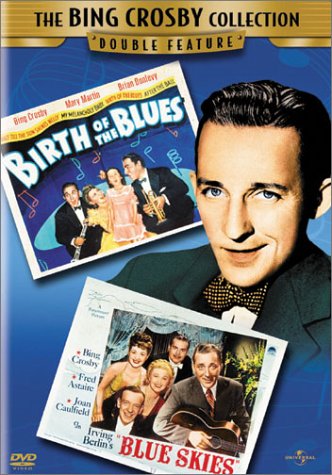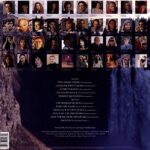Birth Of The Blues/Blue Skies – Double Feature
Birth of the Blues As a child, Jeff Lambert (Bing Crosby) hangs out in New Orleans’ Basin Street, playing hot swing on his clarinet instead of the classics his father prefers. He’s inspired by an African-American group there and, some years later, at the turn of the century, sets out to form a jazz band of his own. With cornetist Memphis (Brian Donlevy), singer Betty Lou Cobb (Mary Martin) and trombonist Jack Teagarden (of the Original Dixieland Jazz Group, after which the story is patterned), he’s on his way. A veritable history of jazz follows. From jump and jive to sweet romanticism, half a century of popular hits is given spectacular treatment. “By the Light of the Silvery Moon” is sung in a theatre with lantern slides on the screen. Singer Ruby Elzy’s “St. Louis Blues” is backed by a chorus of eighty. And “Wait Till the Sun Shines, Nellie” brings Crosby and Martin together in a knockout duet. This bright, bouncy musical is as spirited as they come, and it features “Bing and Mary at their best.” (Louella O. Parsons, Los Angeles Examiner) Blue Skies For what Fred Astaire had announced would be his last film, no expense was spared. This musical extravaganza boasts 30 Irving Berlin songs, 47 sets, sumptuous costumes, and a budget of ,000,000. The result is sensational. (And fortunately, Astaire did not retire from films!) Dancing star Jed Potter (Astaire) and singer/nightclub owner Johnny Adams (Bing Crosby) are both in love with songstress Mary O’Hara (Joan Caulfield). She marries Johnny, but his passion for buying and selling nightclubs drives them apart. So Jed steps in, hoping to win Mary’s heart – until fate steps in and changes the lives of all three. The most outstanding number is Astaire’s famous “Puttin’ on the Ritz,” a split-screen gem with a chorus of miniature Astaires tap-dancing behind him. Designed by Astaire, it took five weeks of “back-breaking physical work” to achieve. Other highlights find Astaire and Crosby as “A Couple of Song and Dance Men,” and Crosby crooning a wealth of Berlin tunes, including the Oscar-nominated “You Keep Coming Back Like a Song.” With its superb stars and sparkling numbers, Blue Skies is one of the all-time great musicals!It’s a flimsy excuse to romp through more than two dozen Irving Berlin songs, but Blue Skies is good fun nonetheless (and one of the top-grossing films of 1946). Bing Crosby is a restless nightclub entrepreneur, Fred Astaire his Broadway buddy, Joan Caulfield the woman they both want. Ignore the plot and enjoy the numbers, especially Astaire’s marvelous “Puttin’ on the Ritz,” which is breathtaking even before multiple images of Fred are introduced dancing in a row (who needs CGI, anyway?). Bing and Fred flash great showbiz chutzpah in “A Couple of Song and Dance Men,” which wonderfully captures the appeal of both stars: Fred’s heavenly precision, and Bing’s “can-you-believe-they’re-payin’-me-for-this?” sense of play.
Bing Crosby founds the first white Dixieland band in Birth of the Blues, a tuneful turn-of-the-century tale–if highly suspect as musical history. Borrowing hot licks from black musicians (Eddie “Rochester” Anderson comments, “Our music sure has gone highbrow”), Bing and his players struggle to invade the straight-laced clubs, succeeding only after songbird Mary Martin joins the band. Martin, in one of her infrequent movie appearances, has fun with Der Bingle jazzing up “Wait Till the Sun Shines, Nellie,” a highlight of this breezily enjoyable nonsense. –Robert Horton
- Factory sealed DVD













